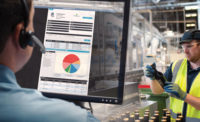Small changes can create significant cost savings in packaging, so it’s no wonder the industrial internet of things (IIoT) is a trend that continues to grow within the broader digital transformation efforts.
Everyone is looking to minimize downtime and waste, maximize throughput and improve on overall equipment efficiency (OEE). Smart deployment of IIoT is uniquely qualified to make this a reality by collecting and analyzing a wide variety of machines, enabling packaging plant managers to improve production planning based on real-time demand, optimize energy use, reduce product and packaging waste and achieve predictive maintenance.
Implementing aspects of the IIoT requires a combination of operational technology and information technology changes, and efforts should touch on the following three core areas.
#1 Full-Factory Connectivity: Networked Controllers, Drives and Sensors
Most modern automated packaging plants already have programmable logic controllers (PLCs) that collect data from multiple points across the system. But they’re likely only gathering enough information to enable real-time automation and nothing more. Information flow is still semi-manual.
Using intelligent, networked controllers, drives and sensors means data can come directly out of the machine, resulting in a much faster flow of information and better business intelligence. This relieves operators and engineers from having to collect data manually and enter it into the existing process software themselves, eliminating the risk for human error and inconsistencies, and letting machine operators and engineers focus on their core work.
Transitioning to fully connected, networked automation components means plant managers and packaging engineers have access to information at both the mechatronic level and the system level almost instantly. With full-factory connectivity, information can be pulled from different parts of the machines, different process steps or from the entire production line to create a more complete picture of the packaging processes across all machines.
#2 Data Collection & Storage: Do You Need Cloud, Fog or Edge?
One of the most disruptive aspects of IIoT has been the need to blur the lines between operational technology and information technology. Cloud computing is now an essential building block in the quest to optimize packaging systems. But simply connecting your data stream to the cloud doesn’t automatically result in process or business intelligence.
Depending on what information you’re gathering and from where, very large volumes of data may be involved. Processing all of it would require significant investment in bandwidth and resources. It’s more than likely, however, that only some of the data are needed — like measured values averaged over a defined period or only the outlying values. In such a case, it would be worth consolidating and analyzing the data with a more decentralized approach, like edge or fog computing.
Edge computing captures and analyzes data closer to the point of collection at the machine or plant level. Fog computing parses the data stream at the transition from the intranet to the internet. A smart combination of cloud, edge and/or fog computing can reduce the volume of data in the network or the resources in the cloud. It also means machines and intelligent devices can continue to collect data even if the internet connection is broken.
Conduct a requirements analysis to determine what is necessary for data transport, storage and processing before choosing the best method, or combination of methods, for your facility. The analysis should also include a discussion around data security and what kind of end-to-end data protection makes sense for your specific situation.
#3 Analytics & Reporting: How to Turn Data into Intelligence
It’s one thing to gather data, but it’s quite another to turn it into actionable insight. Only with smart analysis can the machine and system data be turned into meaningful information, and only then can that information be used to quickly make decisions.
This requires programming an interface to read the data stream and display the right information at the right frequency to the right people. While some packaging plants choose to do it themselves, the cost is significant and requires extensive in-house expertise. Especially if you want to implement predictive production modeling or warning systems that can track critical values and alert operators before failures occur.
Working closely with your IIoT implementation partners to interpret the meaning of the data, based on your goals, is an efficient way to achieve a reliable and useful stream of business intelligence from your data. But be sure to choose your partner, or partners, carefully. Your “product” in a successful IIoT implementation will be the result of the right data science solution for you today, not just an upgrade to existing hardware. Look for a partner with the experience, knowledge and hardware to provide an efficient solution that leverages existing machines while smartly layering on new technologies.
Lenze is a global manufacturer of electrical and mechanical drives, motion control and automation technology. As a global specialist in motion centric automation, the company offers products, drive solutions, complete automation systems, engineering services and tools from a single source. It is a leading provider of automation solutions to the packaging industry, and our other focus industries include automotive, material handling and logistics, robotics and commercial pumps/fans. For more information, visit lenze.com.






